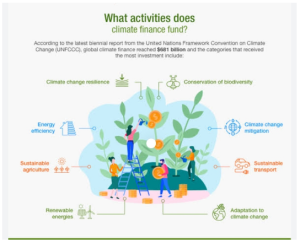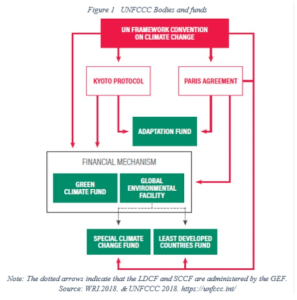Context:
- The Summit for a New Global Financing Pact, hosted by France made progress in addressing the contentious issue of climate financing, but several important issues remain unresolved.
| Probable Question:
Q. Discuss the various challenges faced towards climate financing. Suggest the way forward to achieve atma nirbharta/ self reliance in climate finance. |
What is Climate Financing?

- The United Nations has defined climate finance as the local, national or transnational financing drawn from public, private and alternative sources of financing that seeks to support mitigation and adaptation actions that will address climate change. It will help in the reduction of greenhouse gas emissions projects by helping set up renewable power systems.
- Helping in Adaptation: It also helps communities to adapt to the impacts of climate change by offering simple solutions. For example, resilient seeds can help farmers continue growing food even during droughts.
Climate Financing Mechanism:
- To facilitate the provision of climate finance, the UNFCCC established a financial mechanism to provide financial resources to developing country Parties. The financial mechanism also serves the Kyoto Protocol and the Paris Agreement.
Common but Differentiated Responsibilities and Respective Capabilities (CBDR–RC):
- CBDR–RC is a principle within the United Nations Framework Convention on Climate Change (UNFCCC) that acknowledges the different capabilities and differing responsibilities of individual countries in addressing climate change.
- The principle of CBDR–RC is enshrined in the 1992 UNFCCC treaty, which was ratified by all participating countries
|
- Global Environment facility: It has served as an operating entity of the financial mechanism since the Convention’s entry into force in 1994.
- Green Climate Fund: At COP 16, in 2010, Parties established the GCF and in 2011 also designated it as an operating entity of the financial mechanism. The financial mechanism is accountable to the COP, which decides on its policies, programme priorities and eligibility criteria for funding.

- Special Climate Change Fund (SCCF): It was established under the Convention in 2001 to finance projects relating to: adaptation; technology transfer and capacity building; energy, transport, industry, agriculture, forestry and waste management; and economic diversification.
- Least Developed Countries Fund (LDCF): LDCF was established to support a work programme to assist Least Developed Country Parties carry out the preparation and implementation of national adaptation programmes of action (NAPAs).
- Adaptation Fund: The Adaptation Fund was established in 2001 to provide funding for practical adaptation initiatives in developing nations that are signatories to the Kyoto Protocol and are particularly susceptible to the negative effects of climate change.
Climate financing mechanisms of India:
- NAFCC: The National Adaptation Fund for Climate Change (NAFCC) is a Central Sector Scheme which was set up in the year 2015-16. The overall aim of NAFCC is to support concrete adaptation activities which mitigate the adverse effects of climate change.
- NCEF: The National Clean Energy Fund(NCEF) was created to invest in entrepreneurial ventures and research in the field of clean energy technologies.
- Compensatory Afforestation Fund: The CAMPA funds are utilised for compensating the loss of forest land and ecosystem services by raising of compensatory afforestation, improving quality of forests through assisted natural regeneration, enrichment of biodiversity, improvement of wildlife habitat, control of forest fire, forest protection and soil and water conservation measures.
Concerns/ Challenges associated with Climate Financing:
- Non fulfillment of Commitments by developed nations: Rich countries did not meet the annual $100 billion commitment they made at the 2009 Copenhagen Summit to support developing countries in addressing the impact of climate change
- Non-concessional loans: A large share of climate finance continues to be predominantly delivered as loans, a large share of which has been non-concessional. This has added to debt pressures across regions and income groups.
- Skewed money allocation: As per a report from the Centre from science and environment, the money that is flowing towards climate projects is heavily concentrated in North America, Western EU and East Asia (predominantly China).
- Gap between funding and requirements: Over the past 30 years, numerous funds have been established with numerous commitments. For example, the Special Climate Change Fund, Adaptation Fund, and Green Climate Fund . But there is still and growing distance between expectations and commitment.
- Overstatement of financing: Oxfam Climate Finance Shadow Report 2023 shows that donors claimed $83.3 billion in 2020, but their spending was at most $24.5 billion. The $83.3 billion estimate is inflated because it includes projects with overstated climate objectives or loans at face value.
- Gender-blind financing: Oxfam finds that climate-related development financing is largely gender-blind. Only one-third of 2019-2020 climate finance projects mainstreamed gender, taking into account women and men’s unique needs, experiences, and concerns.
- Double challenge of development and climate financing: Developing countries face the double challenge of simultaneously investing in development and in climate mitigation and adaptation, while addressing the costs of loss and damage.
- Lack of support for LDCs and SIDS: Despite their extreme vulnerability to climate impacts, the world’s poorest countries, particularly the least developed countries (LDC) and small island developing states (SIDS) are not receiving enough support. Instead, they are being driven deeper into debt.
- Loss and damage needs: Oxfam is highly concerned that funding for “loss and damage” .It refers to climate change impacts that exceed human adaptability or when a community lacks the resources to use available options. For example: Rising sea levels could destroy coastal heritage sites, and extreme floods could kill people and destroy homes.
Way Forward:
- Fulfilling the promise: The goal under GCF to raise US$100 billion annually by 2020 to fund climate action in low- and middle-income countries is long overdue. It is imperative to act on the long standing promise.
- Utilization of G20 platform: With Brazil and South Africa to assume the G20 presidency after India, the global south is rising at the world stage, and G20 will be a critical platform to mobilise finances, technical expertise and human resource for the loss and damage fund.
- Framework for assessing loss and damage: India must prioritise creating a framework for assessing loss and damage as a part of its national and sub-national action plans on climate change and disaster risk reduction.
- Social protection schemes like MGNREGA that are creating climate-resilient infrastructure at the grassroots, and weather index-based crop insurance to protect farmers demonstrate how minimizing loss and damage can become a part of public welfare programmes.
- Scaling up grant based financing: There is equally an urgent need for more grant-based financing for climate action, and less momentum toward loaning the money they have all promised to give.
- Climate Responsive development Banks: It is time to make climate change a key parameter of multilateral development banks and enhance their investment in low carbon projects.
- Startup funding: Governments may consider catalytic or start-up funding and capacity building. Catalytic funding should be utilized for ‘repurposing’ key economic activities into green activities.
- Urgent debt relief: A longer-term goal should be to establish a multilateral debt workout process that can help countries break the vicious cycle of worsening debt and climate crises.
- Innovative ways to deploy the IMF’s Special Drawing Rights (SDRs): This could include rechanneling SDRs to multilateral development banks (MDBs), addressing allocation issues to ensure SDRs go to where they are needed most, or considering more ambitious approaches such as new SDR asset classes with specific purposes such as climate resilience.
- Mobilizing private finance towards climate goals: Private capital financing has a vital role in plugging the gaps for global sustainable financing, particularly so in emerging markets and developing economies, where governments are inhibited by capacity constraints.
- Climate proofing investments: Climate proofing investments for coastal areas through mangrove restoration, lowlands affected by floods and for rain-fed regions is another priority for developing nations.
- Coordinated Action: Coordinated strategy between governments, the RBI and the financial sector can manage the concerns of green lending to commercial and marginalized sectors alike.
| Additional Information:
Status of Climate Financing:
- World Bank financing: The World Bank announced a measure to allow countries hit by natural disasters to temporarily suspend debt repayments, but this applies only to new loans.
- IMF’s SDR instrument: It was decided to make an extra $100 billion available to climate-vulnerable countries through the IMF’s special drawing rights (SDR) instrument.
- Funding from developed to developing nations: According to Oxfam, wealthy nations actually contributed between $21 billion and $24.5 billion in 2020 to support climate action in low- and middle-income countries, of which only $9.5 billion to $11.5 billion was designated specifically for climate adaptation.
Recent commitments:
- Loss and Damage (L&D) Fund: A L&D Fund established at the COP27 summit proposed to assist developing countries that have been harmed and are ‘particularly vulnerable’ to the adverse effects of climate change. However, negotiations on its finer details are yet to be worked out.
- Funding for biodiversity loss: The 15th Conference of Parties to Convention on Biodiversity held in Montreal resulted in a global commitment to raise international financial flows from developed to developing countries to at least $30 billion per year by 2030. Some members also committed to mobilise at least $200 billion every year from public and private sources for biodiversity related funding by 2030 but there is no clear roadmap to do so.
SDG and climate financing:
- Delivering meaningful financing solutions is intrinsically connected to our efforts to arrest the backslide of targets set out under the SDGs.
- SDG 13 (which covers climate action): It calls upon states to take urgent action to combat climate change and its impacts.
- SDG 15.5: It calls for taking urgent action to reduce the degradation of natural habitats and halt the loss of biodiversity
|
Indian efforts towards Climate financing:
- First sovereign green bond: India issued the first tranche of its first sovereign green bond worth INR 80 billion. India leads Asian emerging markets (excluding China) in green bond issuance.
- Advocacy of separate climate financing: India raised concerns that financing plans through multilateral institutions could negatively impact its primary objective of lending for development. Therefore, India advocated for climate finance to be treated separately from development finance.
- CDRI: On the global stage, the India-led Coalition for Disaster Resilient Infrastructure, or CDRI, is implementing intergovernmental programmes to develop climate resilient infrastructure. CDRI is well positioned to support the structuring of the loss and damage fund, including developing an operative mechanism, and helping deploy funds to vulnerable countries.
- CBDR-RC: India is raising the issue of climate finance on behalf of the Global South and has been advocating principles of equity and Common But Differentiated Responsibilities and Respective Capabilities.
|
News Source: Indian Express
![]() 24 Jul 2023
24 Jul 2023



